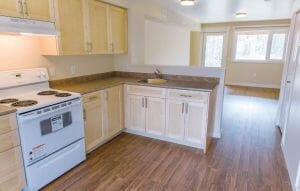Metric Modular's Bella Bella Passive Haus
The project consisted of six, two-story attached townhomes to be used as a desperately needed housing solution for Yale First Nation. Each module was prefabricated at Metric Modular’s Agassiz facility and the modules were approximately 32 feet long and 14 feet wide. After bad experiences with previous onsite builders cutting corners and building poor quality homes, we were able to provide six high-quality housing units for the community. The design of the building allowed each tenant to have a private outdoor space, while still maintaining the feeling of community. As a Passive House, the building was specifically placed on site to take advantage of solar gains and area views.
To meet rigid Passive House standards, each module specification included:
- Efficient building shape – using a ratio known as the ‘Shape Factor’ (the ratio of the buildings surface area divided by its volume) the heat loss from a building envelope is minimized.
- Superinsulation – incorporation of the correct levels of insulation performance depending on the climate zone.
- Advanced windows – using triple glazed units, with two low-e coatings, argon gas fill and insulated frames and spacers.
- Airtightness – prevention of air infiltration and protection against moisture damage.
- Thermal bridge-free construction – preventing an area of the building which has a significantly higher heat transfer than the surrounding materials, resulting in an overall reduction in thermal insulation of the building. Passive House standards reduce energy costs by up to 80 percent, drastically increase occupant comfort and reduce the GHG emissions of the building by 80 percent during occupancy.
As this was our second Passive House project, we were able to save our customer money through the experience we gained during the previous project. We also utilized the three Certified Passive House Consultants on staff rather than hiring expensive outside consultants. Our experienced design, production and site teams were able to prevent building envelope issues before the modules arrived onsite. We were able to reduce the number of pre-tests and consultants’ visits, while still achieving an above average building envelope airtightness test result.
We completed most of the roof construction offsite in order to reduce site work, preinstalling the exterior building envelope (siding), and pre-fabricating porch elements. Previous winter energy bills for the Yale First Nation were in excess of $250 for one month. The energy bill they received after over a month of occupancy was under $20. This on-going savings will make drastic and lasting impact to the economics of this community.
This article originally appeared in the Modular Advantage Magazine - Fourth Quarter 2018 released in November 2018.
More from Modular Advantage
Resia: Breaking All the Rules
Resia Manufacturing, a division of U.S.-based Resia, is now offering prefabricated bathroom and kitchen components to industry partners. Its hybrid fabrication facility produces more precise bathroom and kitchen components (modules) faster and at lower cost than traditional construction. Here’s how Resia Manufacturing does it.
How LINQ Modular Innovates to Bring Modular To The Market in the UAE and Beyond
LINQ Modular, with an office and three manufacturing facilities in Dubai, is a modular firm based in United Arab Emirates. The company is on a mission: to break open the housing and construction markets in the Gulf Cooperation Council (GCC) area with modular.
ModMax: Redefining Modular Construction with Confidence and Precision
ModMax was born out of frustration—frustration with five persistent pain points in modular construction: Permitting bottlenecks. Production delays. Rigid designs. Disconnect between “the office” and the field. Lack of transparency and communication.
LifeArk: Disaster-Resilient Housing from Recycled Plastic and 100-year-old Technology
Wee compares LifeArk’s housing units to Yeti coolers, as they are built similarly. Each component takes 15 to 20 minutes to manufacture, has an R-value of 40, and includes molded slots and chases for wiring, plumbing, fire sprinklers, and other utilities.
Building the Future of Modular Edge Infrastructure
The edge data center market is expanding rapidly, driven by the surge in AI workloads, IoT adoption, and the need for localized compute power. In these environments, sustainability, scalability, and reliability are non-negotiable. Cooling is among the most complex challenges for operators—and one of the most decisive factors in long-term success.
Accelerating Light-Gauge Steel Construction: A Semi-Automated Digital Workflow for Off-Site Projects
For construction professionals, the message is clear. By adopting semi-automation and digitalization, companies can deliver projects faster, more accurately, and more profitably, while also building stronger collaboration across teams. The approach is not about replacing people with machines, but about empowering people with better tools and processes.
Why Modular Data Centers Are Gaining Momentum
Artificial intelligence, high-performance computing, and edge applications push the limits of traditional “stick-built” data centers. They take years build, often struggle with high density workloads, and aren’t optimized for deployments near end users. Modular data center platforms are purpose-built to address these challenges, offering flexibility and scalability to adapt to evolving technologies, while opening new opportunities for the modular construction industry.
Supply Chain Innovation in Action: 5 Habits Every Modular Leader Should Practice
By applying these principles to supply chain practices — collaborative planning, strategic procurement, scenario modeling, digital tools, and transparent forecasting — construction leaders can build value chains that are not just efficient and agile, but truly innovative.
Exploring the Role of Modular Integrated Construction (MiC) in Advancing Circular City Principles – A Survey of Stakeholder Perspectives
The survey findings highlight the significant potential of Modular integrated Construction (MiC) in advancing the development of circular cities. By reducing costs, accelerating construction timelines, and minimizing waste generation, MiC offers a promising approach to sustainable urban development.
The Use of MS POLYMER™-Based Sealants and Adhesives in Modular Building
These products combine flexibility and elastic recovery with excellent adhesion to different substrates and have already shown their usefulness in traditional construction. Now it’s time for them to be put to use in the modular construction industry.










